 |

~ Curious And Unusual ~
- 1 -
'Minerva's Chick' |
 |
The Roman people are notoriously fond of giving nicknames to everybody, even to statues. However, 'Minerva's chick' is indeed a strange way of referring to the small stone elephant that supports an obelisk, located in a square behind the Pantheon.
The monument stands in front of the medieval church named Santa Maria sopra Minerva (St.Mary Over Minerva), run by the Dominican order, whose dedication sprang from the fact of having been built over the ruins of a no longer extant temple dedicated to Minerva, the ancient Roman goddess of knowledge.
With this statue comes a curious story about the main architect and sculptor of Rome's Baroque age: Gianlorenzo Bernini.
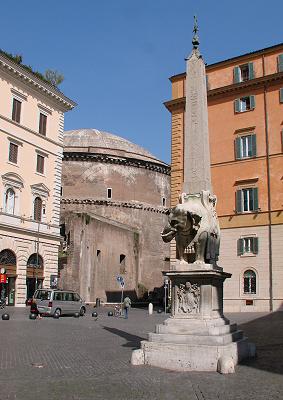
the small monument, with the Pantheon at its back |
| In 1665, a small obelisk about 5.50 m or 18 ft tall, inscribed with hieroglyphs on each side, was discovered
in a garden belonging to the Dominican monastery by St.Mary's church. It was one of the many Egyptian spires that once decorated the Iseum, a very large place of worship dedicated to goddesses Isis and Serapis, whose cult had been imported from Egypt, and had many follwers among the Romans; in the early centuries, the Iseum stood very close to the site of the present church. |
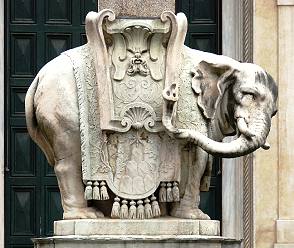
the so-called Minerva's chick |
Pope Alexander VII decided to have the obelisk raised in front of the church. In order to choose a suitable base for the monument, a number of distinguished architects submitted their projects to a papal commission. One of them was a Dominican priest, Father Domenico Paglia. |
According Father Paglia's project, the obelisk would have rested over six small hills, recalling the ones featured in the coat of arms of the Chigi family (left), whom Alexander VII belonged to, with a dog in each corner. In fact, the dog is the symbol of Dominican priests who, after the Latin Dominicanes, were also nicknamed Domini canes, i.e. "the Lord's dogs", to remark their fidelity.

coat of arms of the Chigi
on the monument's base
|
The pope rejected this design, as he wanted the statue to be a symbol of the Holy Knowledge, to recall the original dedication of this site, rather than a self-celebrative monument.
So the famous artist Gian Lorenzo Bernini (whose life and works are also dealt with in Legendary Rome, Bernini vs. Borromini) was then asked to devise a suitable base for the obelisk.
He submitted several drawings, among which one featuring an elephant. The pope chose this one, as an allegorical representation of fortitude: "...a strong mind is needed to support a solid knowledge", reads the inscription on one side of the base.
|
|
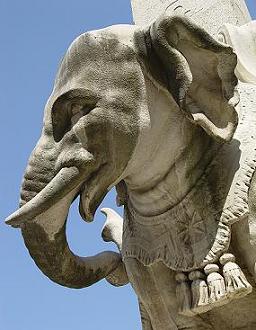
the small elephant drawn by Bernini |
In drawing his elephant, Bernini had been inspired by
Hypnerotomachia Poliphili ("Poliphil's Dream Of The Love Battle"), a novel written in the 15th century by Francesco Colonna that was rather well-known in those times. First issued in Venice in 1499,
Hypnerotomachia had been one of the very first books ever printed in Italy, by the famous printer Aldus Manutius. The same pope Alexander VII, who was highly cultured, owned a copy of this book.
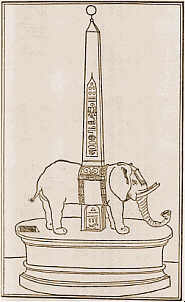
Hypnerotomachia Poliphili:
the elephant with the obelisk |
In the novel, full of symbolic references, Poliphil encounters an elephant made of stone that carries an obelisk; it is easy to tell how much Bernini's idea was inspired by this work by comparing his monument with the original illustration from the book's first edition (left).
In the sculptor's original plan, though, the obelisk would have fully rested on the elephant's four legs, without a stand below the animal. But Father Paglia, who was rather envious after his own project had been rejected, argued that according to traditional canons, by which no weight should rest vertically above an empty space, as it would not be steady nor long-lasting, a cube should have been inserted under the elephant's belly, just as the one featured in the illustration from the Hypnerotomachia. |
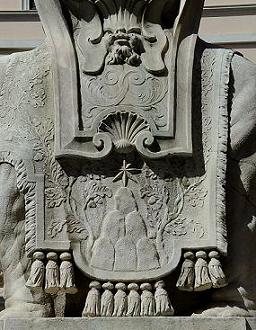
the elephant's saddle-cloth, featuring the oak tree
and three hills, family device of Alexander VII |
Bernini strongly opposed this alteration, since he had already carried out other works in which heavy
elements rested over an empty space (an example is his well-known Fountain of the Rivers in piazza Navona),
but the pope decided to have the cube added to the statue all the same.
The sculptor then tried to disguise the rough cube by adding an elaborate saddle-cloth to the elephant's back in order to cover the cube but, despite his attempt, the change still gave the statue a rather stout look.
For this reason, after having been raised in the square on July 11, 1667 (meanwhile, the pope had died about 40 days before), the people of Rome nicknamed it Porcino della Minerva ("Minerva's Piggy"). The name probably changed into Pulcino ("Chick") for a mere phonetic reason: in time, when the memory of this fact fell into oblivion, the people mya have likely mistaken the word porcino with purcino, which is in fact the Roman dialect word for "chick".
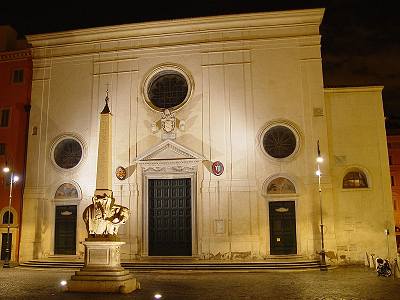
the monument and the church at night-time |
Bernini took revenge upon the Dominican who had dared to challenge him: in the final version of the statue, carved in 1667 by one of his best apprentices, Ercole Ferrata, he drew the elephant pointing towards the nearby monastery with his rear end, the tail slightly shifted to the left, in the attitude of saluting Father Paglia and the other friars in a rather... obscene way! |
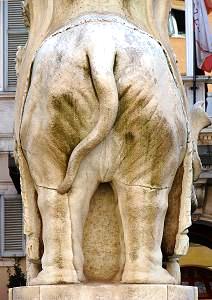
what Father Paglia saw from the convent |
|